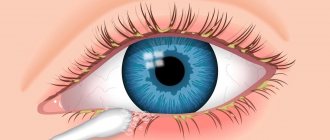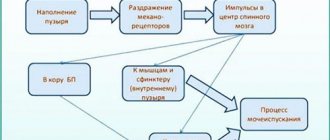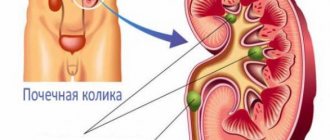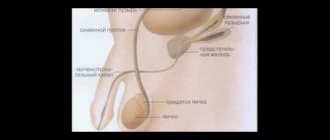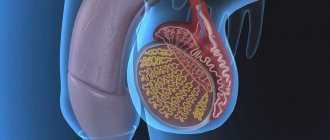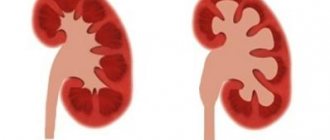The formation and development of a pampiniform plexus of veins in the scrotum, which occurs due to changes in the outflow of venous blood, varicose veins in the testicle or spermatic cord, is called varicocele. Pathology provokes an increase in temperature inside the organ, edema, and ischemia. The consequence may be testicular atrophy and infertility. In 40% of all men suffering from fertility disorders, problems are caused by varicocele.
Most often, the pathology affects the left testicle; signs of varicocele on the right testicle or on both sides appear in rare cases.
Using the latest equipment, specialists from the State Institute of Urology will quickly and accurately establish a diagnosis and select the most appropriate treatment according to an individual scheme.
Varicocele - diagnosis and treatment
Varicocele is a varicose vein in the testicle and spermatic cord. Varicocele is one of the most common diseases among men, which often leads to very unpleasant consequences.
Causes of varicocele
Varicocele develops as a result of two reasons.
1. Congenital weakness of the vascular wall. Most often, varicocele develops as a result of a genetic predisposition to this type of problem. Almost always, one of the relatives of a patient with varicocele has varicose veins of the extremities, flat feet, heart valve defects, phimosis or other manifestations of connective tissue insufficiency. Often these diseases accompany each other.
2. Increased blood pressure in the veins of the pelvis or scrotum. In fact, it is more of a predisposing factor than a cause of the disease. But sometimes there are such pronounced anatomical changes leading to increased pressure in the veins that this factor becomes the cause of varicocele. The testicular vein can bend, be pinched by other vessels, pass through folds of tissue, etc. All this leads to a narrowing of the lumen of the vein and, as a result, an increase in pressure in it.
Less commonly, an increase in blood pressure in a vein is caused by general phenomena - chronic constipation or diarrhea, heavy lifting, tension in the abdominal muscles, etc. These factors can contribute to the development of varicocele, but are unlikely to cause the disease.
Why and how does varicocele disease occur?
The veins of the scrotum carry blood from the testicle and surrounding tissues to the heart. In this case, blood flows from bottom to top, against gravity. Normally, the reverse flow of blood through the veins is prevented by a special valve apparatus in the venous wall. When the veins dilate, these valves stop working, as a result of which the blood begins to make so-called “pendulum-like movements” in the vein. As a result, blood flow slows down sharply, and the blood supply to the testicle as a whole suffers.
Impaired blood supply to the testicle leads to the fact that its oxygen-depleted tissues begin to function worse. In addition, testicular temperature is normally several degrees lower than body temperature. With varicocele, the testicle is surrounded by a plexus of dilated veins, its temperature becomes equal to body temperature, and the function is inhibited even more. All this leads to the appearance of symptoms of the disease.
Degrees of development of varicocele
Based on how dilated the veins of the testicle and spermatic cord are, 4 degrees of varicocele are distinguished.
1st degree - testicular veins cannot be palpated by hand, their varicose veins are determined only instrumentally (ultrasound, Dopplerography). 2nd degree - dilation of the veins can be felt in a standing position; in a lying position, the varicocele is not detected. 3rd degree - dilated veins can be felt both in a standing and lying position. 4th degree - dilated veins of the testicle and spermatic cord are visible to the naked eye. Most often, varicocele develops in young men during puberty, quickly reaches a certain degree and no longer progresses. It is extremely rare that one degree of varicocele passes into another.
Almost always, varicocele is left-sided. It is very rare to encounter a bilateral varicocele, and it is extremely rare that a varicocele develops on the right.
Manifestations of varicocele
As already mentioned, with varicocele, testicular function suffers. This can manifest itself in two ways - either pain or discomfort occurs in the testicles, or the man becomes infertile.
The described symptoms occur differently in different men with varicocele. If we take all men suffering from varicocele as 100%, then half of them will not have any manifestations of the disease, 25% will experience discomfort in the testicle and 25% will suffer from infertility. Moreover, these numbers do not depend in any way on the stage of the disease.
Pain in the testicles with varicocele.
Most often, pain or discomfort is of a pulling, pressing nature; patients often describe this condition as heaviness in the scrotum. Typically, these sensations are not present all the time, but appear after physical activity, sexual intercourse, thermal procedures, or after a long period of inactivity.
It is not at all necessary that unpleasant sensations in the scrotum with a left-sided varicocele appear on the left. Most often, patients find it difficult to determine in which half they are more pronounced, and often the pain is localized mainly on the right.
Infertility and varicocele.
Among all men suffering from infertility, varicocele is observed in 40% of them. However, it is relatively rare that varicocele manifests itself with any other symptoms. Therefore, all men whose sperm count does not correspond to the norm must undergo an examination in this regard.
Violation of the blood supply to testicular tissue and its thermoregulation leads to inhibition of the function of the spermatogenic epithelium. As a result, the number of sperm in the spermogram may decrease, their motility and morphology may deteriorate. But this is not all the mechanisms of infertility with varicocele.
Testicular tissue belongs to the category of so-called barrier tissues. This means that normally the body's immune system never encounters testicular tissue and is not “familiar” with it. With a varicocele, the venous wall may no longer act as a barrier. In this case, immune factors reach the testicular tissue and begin to perceive it as foreign tissue. The so-called aseptic autoimmune inflammation develops. It is expressed more strongly the better the immune system of a man’s body is. The worst thing here is that the antibodies produced also affect the healthy testicle, causing the same inflammation in it.
Asymptomatic varicocele.
This is the most common variant of the disease. Most cases of varicocele are asymptomatic and do not bother the person in any way. Many men live with varicocele all their lives, have children and do not know anything about this disease. Often, a varicocele turns out to be an accidental discovery during an examination or a comprehensive examination (checkup) for a completely different reason.
As already mentioned, varicocele rarely progresses, so if there are no symptoms of the disease, then they most likely will not appear. However, the opposite often happens - older men experience pain in the testicles or changes in the spermogram associated with varicocele.
Diagnosis of varicocele
Starting from the second degree, varicocele is detected by a urologist during examination. If the enlargement of the veins is significant and the diagnosis leaves no doubt, then no additional examination is required. If the degree of varicocele is small, then a special examination is necessary.
Ultrasound or Doppler ultrasound of the scrotum.
If a varicocele is suspected, ultrasound or Dopplerography must be performed in two positions of the patient - lying and standing. If this is not done, the examination loses all meaning.
Which examination method to choose does not matter much. Doppler sonography is more accurate and allows you to definitively confirm or refute the diagnosis. However, an ultrasound scan of the scrotum performed by a competent specialist also dispels all doubts about the diagnosis of varicocele.
Dopplerography or ultrasound of the scrotum in lying and standing positions must be performed for all men with infertility and pain in the testicles.
In addition to all that has been said, in case of varicocele a spermogram must be taken.
Treatment of varicocele
There are only surgical methods for treating varicocele. If you hear somewhere about treating varicocele without surgery, do not believe it; there is no effective treatment for varicocele without surgery.
Surgery for varicocele must be performed if the disease manifests itself as pain in the scrotum or infertility. In both cases, getting rid of varicocele is the only way to get rid of the manifestations of the disease.
If nothing bothers a man with varicocele, the need for surgery is a controversial issue. It is usually decided based on the possibility of infertility. If a man still expects to have children, then it is better to have an operation; if not, then you can do without it. Most often, it turns out that if a varicocele is found in a teenager or a young man, then it makes sense to get rid of the disease, but if we are talking about an older man, then this is not necessary.
There are several types of operations for varicocele, and they are all divided into two types.
=> 1 type. The essence of this type of operation is to completely ligate, cut or remove the varicose vein.
The following happens. Before the operation, blood flow through the vein was slow. After the operation it stops completely. For the body, this situation is stressful, and this stress leads to the opening of new pathways for the outflow of blood from the testicle. As a rule, the superficial veins of the scrotum are involved.
The advantages of operations of this type are: relative ease of execution, minimal volume of surgical intervention, minimal time spent in hospital, lower cost compared to operations of the second type.
Disadvantages: relatively high percentage of relapses and non-physiological nature of the operation.
Relapses during operations of the first type are due to the fact that the veins in each person are located individually and can vary within a very wide range. If a branch comes off from a varicose vein, and during the operation this branch is not noticed and is not tied up, the operation will not give any result. This is usually called a relapse of the disease, but in fact it is simply the ineffectiveness of treatment.
For different operations of the first type, the percentage of relapses is different, depending on the type of operation it ranges from 10% to 40%.
The second drawback is the non-physiological nature of these operations. As already mentioned, the result of the operation is the complete cessation of blood flow through the dilated vein. As a result, the testicle is left without blood circulation, and under the influence of this stress, new pathways for blood discharge are opened.
This process takes about a week. During this week, the testicle often begins to hurt, and if there was pain in the testicle before, it noticeably intensifies. There is also evidence that during these events, the barrier between testicular tissue and the immune system may be disrupted, as a result of which antisperm antibodies appear in the blood, and the man develops or progresses infertility.
There are quite a few types of type 1 operations for varicocele. The more common ones are the Ivanissevich operation, the Marmar operation and the endoscopic operation.
=> 2nd type. During this type of operation, the veins of the testicle are completely removed, and then they are restored - plastic surgery. This type of operation is represented by only one type of operation, which is called microsurgical testicular revascularization.
The advantage of this operation is that immediately after the operation normal blood circulation is restored to the testicle. Varicose veins are completely removed, and recurrence of the disease is completely excluded. After microsurgical revascularization of the testicle, the patient does not experience pain for a week, as with type 1 operations.
Disadvantages of the operation: high complexity of the surgical intervention, longer hospital stay, higher cost of the operation.
Choosing a surgical method for varicocele
The choice of surgical method should be based on the manifestations of the disease on the one hand and financial capabilities on the other. The final choice of surgical method is made jointly by the patient and the doctor who will perform the operation. But very often the patient himself is excluded from the choice of surgical method and is not provided with complete information.
Therefore, we will consider here the most frequently occurring cases.
1. Varicocele is accompanied by severe pain in the scrotum area. In this case, microsurgical testicular revascularization is the optimal choice. With all other methods of surgery, a significant increase in pain is possible in the postoperative period.
2. Varicocele is accompanied by moderate pain or discomfort in the scrotum. Microsurgical testicular revascularization remains the most acceptable procedure. But in general, any method of surgery is suitable, you just need to be prepared for an increase in these sensations in the first week after surgery.
3. Varicocele is accompanied by changes in the spermogram. The only correct choice is microsurgical testicular revascularization. Other methods of surgery can lead to progression of infertility.
4. Varicocele is asymptomatic, discovered by chance, the patient is a young man who expects to have children in the future. The operation must be performed; the choice of method depends only on the patient’s capabilities. Preference should be given to either microsurgical testicular revascularization or endoscopic surgery.
5. Varicocele is asymptomatic, the patient is a middle-aged man who does not expect to have any more children. The need for treatment in such a situation is highly questioned, since nothing prevents one from continuing to live with this disease. If the patient insists on surgery, any method of treatment is quite suitable.
6. Recurrence of varicocele after previous operations. Repeated intervention is required, the most optimal is endoscopic surgery, microsurgical revascularization can also be performed.
7. Bilateral varicocele. Endoscopic surgery will allow you to get rid of the disease in one stage of the operation; all other methods require separate intervention for the right and left sides. But in case of development of infertility or severe pain in the scrotum, the choice should be microsurgical revascularization of the testicle.
Prevention of varicocele
Varicocele develops mainly due to an anatomical or genetic predisposition to this disease. Therefore, we are not talking about any special prevention of varicocele. After the end of puberty (19-20 years old), it makes sense to undergo an examination by a urologist, and if no signs of varicocele are found, you don’t have to worry about this.
If you already have a varicocele, you should try to avoid heavy physical activity and problems with bowel movements. Both lead to increased intra-abdominal pressure and, as a result, blood pressure in the veins of the pelvis, which can lead to progression of the disease.
For testicular pain caused by varicocele, cold applied to the scrotal area and the use of vasoconstrictor drugs can help. On the contrary, vasodilating medications and heat are contraindicated in such a situation.
It is also recommended to check for hidden sexually transmitted infections and a complete check of the male genitourinary system ( checkup ).
This can be done by making an appointment with the urologists of the “ Dr. Filatov Clinic ” by calling:
(812) 312-65-65 and 716-26-86
Minimally invasive surgeries
Treatment of varicocele is increasingly performed using microsurgery. Such operations are characterized by the creation of a small hole in the patient’s lower abdomen, through which the entire length of the ovarian vein is brought out. The surgeon completely excises the affected area, and instead of the removed tissue, the epigastric vein is sutured. Endoscopic interventions, during which three punctures are made to the patient, are also considered minimally invasive operations. Instruments and a laparoscope are inserted through the holes, intended for visual inspection of the damaged area. The affected vein is excised using titanium staples. Minimally invasive operations are not only less traumatic, but also have a shorter rehabilitation period.
The most revealing statistics of postoperative complications for 2021
Based on the results of its activities in 2016, the Capital Varicocele Clinic managed to achieve significant results in the effectiveness of the treatment provided. The use of Marmara microsurgical technology and the introduction of innovation - performing the operation through an incision in the scrotum - made it possible to achieve 100% treatment success. Of all the patients who came to the clinic, only 1.4% of the operated men had inflammatory processes, and this complication is associated with non-compliance with the dressing regimen.
This side effect was eliminated by prescribing antibiotics. The relapse rate was 0%, not a single patient of the clinic encountered hydrocele, and all those who sought treatment received a lifetime guarantee from the institution for the Marmara operation.
This method of treatment involves operating only on varicose veins - these are 6-18 veins of the vessels of the pampiniform plexus. The technique allows you to preserve the vein of the vas deferens 100% and not affect the blood circulation in the testicle. Within 3 weeks, 100% of venous blood flows through the vas deferens, eliminating the threat of infertility. Such statistics are the most successful in Russia.

